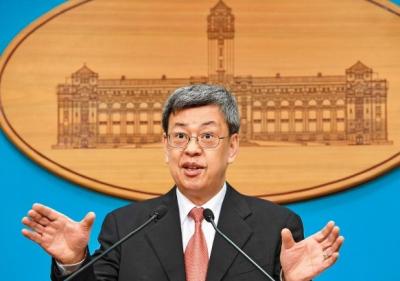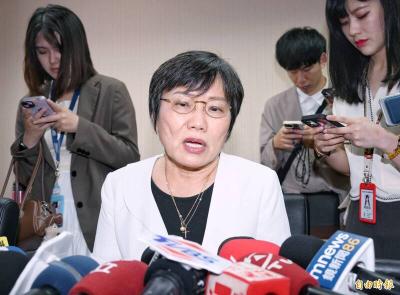Taiwan is the primary target of a Chinese campaign of political warfare, according to a new study by a Washington-based think tank.
The 40-page study by Project 2049 Institute executive director Mark Stokes and senior fellow Russell Hsiao was published this week.
“Taiwan’s democratic system of government — an alternative to mainland China’s authoritarian model — presents an existential challenge to Chinese Communist Party (CCP) political authority,” the report said.
With political legitimacy across the Taiwan Strait viewed as a zero-sum game within the international arena, authorities in Beijing have long sought the political subordination of Taiwan, it added. As a result, a “coercive persuasion campaign” intended to manipulate international perceptions of the “one China” model and undermine Taiwan’s international legitimacy, is being waged, the paper said.
Beijing runs a “complex network” designed to influence the policies of the US, Taiwan and other countries, it said, adding that several party and state organizations engage in political warfare, but under the leadership of the CCP Central Military Commission, the Chinese the People’s Liberation Army (PLA) General Political Department Liaison Department is the PLA’s principal political warfare command.
“Political warfare is the employment of instruments of national power — short of war — to achieve foreign policy goals,” the study said.
Chinese political warfare seeks to shore up legitimacy domestically, reframe international rules of the road and promote alternatives to widely accepted universal values, it added.
“While the US is viewed as an ideological adversary, Taiwan remains the central focus of PLA political warfare,” the study said.
“The objective reality is that Taiwan, under its current ROC [Republic of China] constitutional framework, exists as an independent, sovereign state. The two equally legitimate governments — the PRC [People’s Republic of China] and ROC — are currently committed to ‘one China’ principles, under which they exercise exclusive administrative jurisdiction over the territory under their respective control, with neither side subordinate to the other,” the report said..
“In the context of the US ‘one China’ policy, a ‘one China, two governments’ framework may serve as the most accurate representation of the ‘status quo’ in the Taiwan Strait,” it went on.
However, with Taiwan seen as a challenge to the CCP’s monopoly on power, authorities in Beijing have long sought the political subordination of Taiwan under a “one country, two systems” principle, the paper said, adding that in the near term, Beijing appears focused on creating the conditions for early initiation of cross-strait political negotiations on terms favorable to it.

Taiwan would welcome the return of Honduras as a diplomatic ally if its next president decides to make such a move, Minister of Foreign Affairs Lin Chia-lung (林佳龍) said yesterday. “Of course, we would welcome Honduras if they want to restore diplomatic ties with Taiwan after their elections,” Lin said at a meeting of the legislature’s Foreign Affairs and National Defense Committee, when asked to comment on statements made by two of the three Honduran presidential candidates during the presidential campaign in the Central American country. Taiwan is paying close attention to the region as a whole in the wake of a

President William Lai (賴清德) has appointed former vice president Chen Chien-jen (陳建仁) to attend the late Pope Francis’ funeral at the Vatican City on Saturday on his behalf, the Ministry of Foreign Affairs said today. The Holy See announced Francis’ funeral would take place on Saturday at 10am in St Peter’s Square. The ministry expressed condolences over Francis’ passing and said that Chen would represent Taiwan at the funeral and offer condolences in person. Taiwan and the Vatican have a long-standing and close diplomatic relationship, the ministry said. Both sides agreed to have Chen represent Taiwan at the funeral, given his Catholic identity and

Chinese Nationalist Party (KMT) Chairman Eric Chu (朱立倫), spokeswoman Yang Chih-yu (楊智伃) and Legislator Hsieh Lung-chieh (謝龍介) would be summoned by police for questioning for leading an illegal assembly on Thursday evening last week, Minister of the Interior Liu Shyh-fang (劉世芳) said today. The three KMT officials led an assembly outside the Taipei City Prosecutors’ Office, a restricted area where public assembly is not allowed, protesting the questioning of several KMT staff and searches of KMT headquarters and offices in a recall petition forgery case. Chu, Yang and Hsieh are all suspected of contravening the Assembly and Parade Act (集會遊行法) by holding

Lawmakers from the Democratic Progressive Party (DPP) yesterday established a friendship group with their counterparts in Ukraine to promote parliamentary exchanges between the two countries. A ceremony in Taipei for the Taiwan-Ukraine Parliamentary Friendship Association, initiated by DPP Legislator Chen Kuan-ting (陳冠廷), was attended by lawmakers and officials, including Deputy Minister of Foreign Affairs Francois Wu (吳志中) and European Economic and Trade Office in Taiwan Director Lutz Gullner. The increasingly dire situation in Ukraine is a global concern, and Taiwan cannot turn its back when the latter is in need of help, as the two countries share many common values and interests,